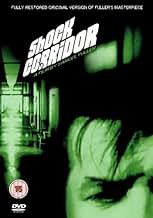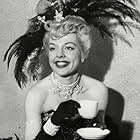Bent on winning a Pulitzer Prize, a journalist commits himself to a mental institution to solve a strange and unclear murder.Bent on winning a Pulitzer Prize, a journalist commits himself to a mental institution to solve a strange and unclear murder.Bent on winning a Pulitzer Prize, a journalist commits himself to a mental institution to solve a strange and unclear murder.
- Awards
- 3 wins & 2 nominations total
Bill Zuckert
- 'Swanee' Swanson
- (as William Zuckert)
- Director
- Writer
- All cast & crew
- Production, box office & more at IMDbPro
Storyline
Did you know
- TriviaBecause of the film's budget and the size of the sound stage, Samuel Fuller hired little people to walk around in the far section of the corridor to give audiences a greater sense of depth.
- GoofsThe opening quotation, "Whom god wishes to destroy he first makes mad" is incorrect since though the idea probably originates in ancient Greece, the ancient Greeks were polytheistic and would have referred to 'the gods,' and the attribution to Eurypides is false.
- Quotes
Johnny Barrett: Nymphos!
- Crazy creditsThe quote "Whom God wishes to destroy, he first makes mad". Euripides 425 B.C." appears at the beginning and end.
- ConnectionsEdited from House of Bamboo (1955)
- Soundtracks(I Wish I Was in) Dixie's Land
(uncredited)
aka "Dixie"
Music by Daniel Decatur Emmett
Whistled by James Best (Stuart); also played on the piano during the dance therapy session.
Featured review
A journalist, determined to expose a murder, gets himself thrown into the mental hospital in which it occurred. While there, he has to fight to retain his sanity. This exposé and the murder, they're McGuffins. The film's biggest flaw is that these McGuffins are left so untouched (does Barrett actually believe that anything he might prove by interviewing mental patients will stand up in court?), which makes the allegorical part of the film stand out a bit too much. Fortunately the allegory is powerful and is well done. Amazingly, these major criticisms of American society, delivered in monologues by three very good performers, exist in this film, made in 1963. The tightness of the post-WWII generation was weakening a bit at the time, but the kind of things that are expressed here, exposing the paranoia and bigotry and the belligerence of the American hoi polloi, it's daring. I suppose it was allowed because this was obviously meant to be an exploitative B-movie and play to a small audience. Shock Corridor is probably most famous for its style, and that fame is very much deserved. The harsh lighting is gorgeous, as is all of the cinematography, in general. The choppy editing, probably influenced by the French New Wave that was taking place at the time, is also rather good. The acting is adequate. It's certainly not an actors' film, and the leads are easily forgettable. However, some of the inmates give good performances. Hari Rhodes as Trent is probably the most memorable. He plays the first black student at a Southern university (not the historical one, but a fictional composite). He was driven insane by the bigotry around him, and now he thinks he's a Grand Dragon of the KKK (and he thinks he invented it). The film does fall into that mental hospital movie of giving all the inmates wacky problems. I don't know of any earlier mental hospital movies offhand, so maybe this set that trend. In this film, it's not nearly as annoying as it is in movies like One Flew Over the Cuckoo's Nest, which was, despite Shock Corridor, the parent of movies like Girl Interrupted and The Princess and the Warrior. 9/10.
- How long is Shock Corridor?Powered by Alexa
Details
- Release date
- Country of origin
- Language
- Also known as
- Straightjacket
- Filming locations
- Kotoku-in, Kamakura, Kanagawa, Japan(dream sequence: Great Buddha of Kamakura)
- Production companies
- See more company credits at IMDbPro
- Runtime1 hour 41 minutes
- Color
- Aspect ratio
- 1.85 : 1
Contribute to this page
Suggest an edit or add missing content























